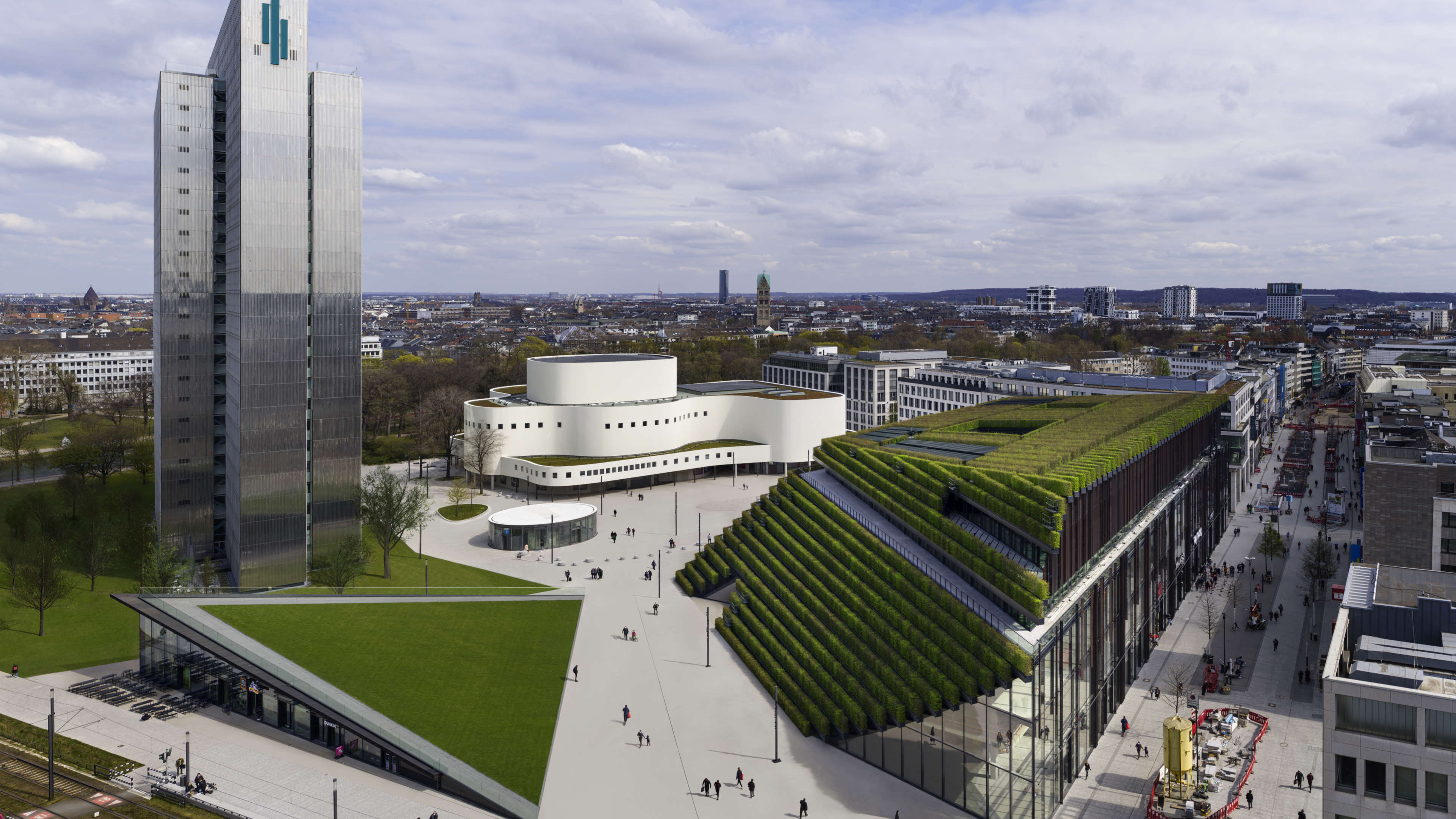Kö-Bogen II Düsseldorf
ingenhoven architects

Products
Sustainable architecture for Düsseldorf city centre
There is a kind of architecture that produces built space yet is still amenable to life outside and to more besides, that adopts a credible stra¬tegy for dealing with climate change in cities, extreme heatwaves for instance. The Kö-Bogen II project by ingenhoven architects boasts the largest green façade currently in existence in Europe – five miles of hornbeam hedging line the roof at a height of 89 feet along with two sides of the main building facing Gustav Gründgens Square. A façade some 89 feet high and 394 feet long running along Schadowstrasse is, by contrast, glazed. Expanded-mesh slats help structure the feel of the interior here, their degree of transparency varying from closed to open as a function of from where they are viewed.
Christoph Ingenhoven has been providing fresh impetus for reconceiving the centre of his home city since 1992. Completion of Kö-Bogen II brings Düsseldorf’s greatest ever urban-planning repair project to a successful conclusion. Key milestones in this process were Daniel Libeskind’s Kö-Bogen finished in 2013 and the demolition of the “Millipede” elevated road that same year. The road’s demise altered spatial perceptions so markedly that the competition for Kö-Bogen II had to be re-adjudicated – in favour of the tender by ingenhoven architects.
The unusual outlines of the new two-section office and commercial ensemble, which contains over 441,000 square feet of floorspace for retailing, catering and officing purposes, were dictated by the nature of the plot available. The sloping green façade to the trapezoidal five-storey main building and the greened sloping roof to a smaller triangular structure dive down dynamically onto Gustaf Gründgens Square from either side. Anyone approaching from Schadowstrasse or Berliner Allee has an unimpeded view of the listed post-war duo comprising the “House in Three Slices” (1960, HPP Archi¬tects) and a theatre building (1970, Bernhard Pfau, refurbished by ingenhoven architects) as well as of the royal court garden behind.
Architect and Building
Photo: © Jim Rakete
Three differing architectural approaches have fused into a coherent urban whole in Düsseldorf’s new green city-centre: “the severe lines of the House in Three Slices”, “the curvaceous airiness of the theatre” and the dynamic green façades to Kö-Bogen II. They all testify to the ages in which they were built without in any sense vying for supremacy.
Giving the city as much green back as possible
The sloping roof to the triangular building has been grassed over and can be walked on – a picnic lawn that further contributes to enhancing the attractiveness and social benefits offered by the new centre. Sustainability and architecture have long been companions for Chris¬toph Ingenhoven. He summarises his approach as being supergreen® – a holistic system of insights and aspirations that is being ongoingly refined. One of the central themes is the thought of giving the city as much green back as possible.
Kö-Bogen II provides a potential “contemporary response by cities to climate change” with its green façade. The façade’s vegetation takes the form of 30,000 hornbeam plants. It acts as a natural cold storage device and hence reduces the inner-city warming effect, it conserves rainwater, thus closing a gap in the water cycle, it binds carbon dioxide and particulate matter, it supports biodiversity and it also improves human wellbeing in general. It is only logical, then, that ingenhoven architects also opted for a sustainable premium product from Germany where the ironmongery was concerned.
FSB pro¬ducts are certified to the stringent provisions of ISO 14025/German Sustainable Building Council (DGNB) and are ideally suited to such projects. Resort was had here to handle 1078 and the return-to-door variant 1088, both authored by Christoph Ingenhoven himself. Their design draws on the basic idea from a handle classic by Robert Mallet-Stevens, which is supplied as model 1076 in the FSB range of products. Ingenhoven interprets the “Frankfurt Model” afresh by varying the shape of its mitring and grip. The transition from the circular styling of the handle’s shank to its flattened grip section has been accomplished to particularly appealing effect.
Detailed views
Photos: © Hans Georg Esch








